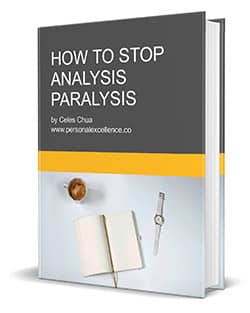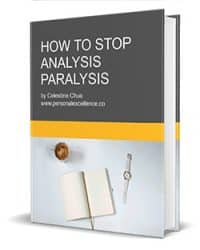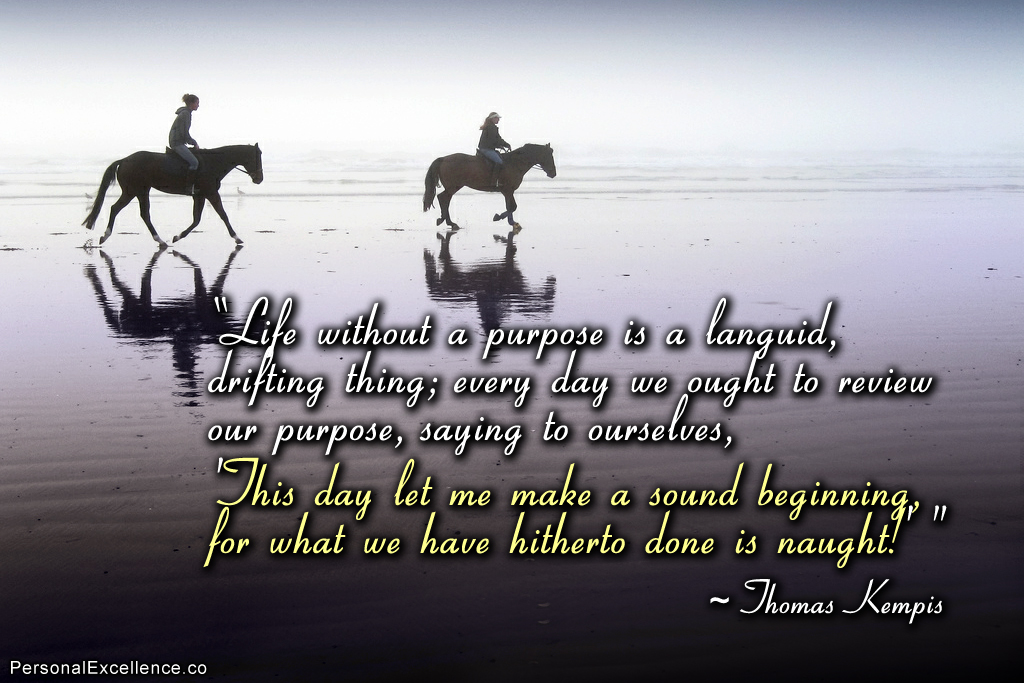

“Celes, after 25 years of marriage, I find myself alongside someone from whom I’ve grown apart. I’ve lost all desire to be with this person and yet the thought of being without him scares me to pieces.
I’m a successful businesswoman who is able to make some very high-powered decisions on the spot, but the one very important decision in my own life is the one I flounder with like a fish out of water. I just cannot seem to sort through this one.
And so to you I ask: How do you sort through one of life’s greatest decisions such as this?” — Joi
What do you do when faced with a big decision which you don’t know the answer to?
Do you opt for the middle road? Do you sacrifice your needs for others? Do you randomly pick an option and hope for the best? Do you put off the decision and hope everything will sort itself out?
Today, I share my three methods to break out of any dilemma.
Method #1: Fast Forward To The Future
My first method is the Fast Forward Method. Whenever you play a video on a video player, there is a fast-forward button to skip to a later part of the video. Well, the Fast Forward Method is where you project yourself into the future with a particular option, and then ask yourself if this is what you want.
How does this help? Firstly, our judgment often gets clouded when we’re deep in a situation. It’s common to get caught up with concerns — concerns that may well not matter in the long run. Fast-forwarding to the future helps us see more clearly the things that matter, and the things that don’t. Things that are important to us now may well not matter in the long run. Conversely, things that seem unimportant to us now may well be very important in the long run.
Secondly, by projecting yourself into the future, the pros/cons of that option get magnified. You see the realities of each option and what’s going to happen next. It helps you evaluate if choosing a particular option will bring you to where you want, rather than waste years of your life to find out.
How To Use This Method
- Pick a dilemma you’re facing right now. It can be regarding your relationship, marriage, work, friendship, health, or other life areas.
- What options are you considering for this dilemma?
- Apply the Fast Forward Method to each option.
- Imagine if you take Option A. What would your life be like a year from now? Three years? Five years? 10 years? See the years go by as you live life on this path. What would you be doing? How would you feel?
- Repeat the above with Option B, then Option C, etc.
- Which scenario do you want to be in? This is the option for you.
Example: Quit My Job
One of the biggest decisions in my life up till my mid-20s was whether I should quit my job to pursue my passion.
My dilemma then was not whether to stay at my job or pursue my passion. I already knew that I wanted to pursue my passion. My dilemma was between (a) quitting my job right away to pursue my passion, and (b) working for a few more years before quitting, to save more money. Option A would fulfill me greatly since I would get to pursue my passion right away. Option B would let me pursue my passion with a larger savings buffer.
Initially, I couldn’t decide because both options had their pros and cons. Each seemed like a viable path.
As I weighed between both options, I mentally fast-forwarded myself one year into the future. Which path do I want to be on, a year from now? I asked myself.
Quit right away and pursue my passion, a voice rang inside of me. There was not even a moment of doubt. It was so clear that this was what I needed to do.
Why? Because even if I were to pursue my passion and make little progress after 1-2 years, I would still make more progress than if I continued on in my day job. My day job wasn’t going to bring me closer to my dreams except to give me more savings. I already had savings to last me for two years. To work an extra day in my job meant delaying my passion for another day, and subsequently delaying my dreams.
In fact, the further I fast-forwarded myself, the clearer my answer was.
- One year into the future? “Yes, I should definitely quit now and pursue my passion.”
- Three years into the future? “I can’t believe I’m so conflicted about this. It’s so obvious that I should quit!”
- Five years? “What’s there to consider?? This job has no role in my long-term vision. Hurry up and quit now!!”
- 10 years? The same answer as before!
By fast-forwarding myself 1/3/5/10 years into the future, I was able to evaluate the situation more objectively. While I was worried about short-term money issues, this fear was irrelevant as (a) I already had savings to last me for a while, and (b) if I ran out of money, I could easily return to work. I couldn’t see this until I visualized myself 1/3/5/10 years into the future.
Method #2: Ideal Vision
Albert Einstein once said, “No problem can be solved from the same level of consciousness that created it.” This is very true.
If you want to break out of your current dilemma, you need to adopt a different frame of mind — the mind of someone who has achieved your ideal goal. This brings us to the Ideal Vision Method.
How To Use This Method
For the dilemma you’re facing,
- What is your ideal vision for this area of your life? For example, if you’re considering between two job options, what is your ideal vision for your career? If you’re considering whether to marry someone, what is your ideal vision in the area of love?
- Which option will bring you to your ideal vision?
Example: Stay Married or Divorce
Let’s say like reader Joi, you have been married to your partner for 25 years. While you have lost all desire to be with him, you are afraid to file for divorce. Maybe you are afraid to be alone. Maybe you are afraid of social stigmas. Maybe you are afraid of the unknown, of dealing with legal fees, of going through the divorce process, or of facing life as a divorcee.
Here, ask yourself:
- What is my ideal vision in the area of love?
- Which option brings me to my ideal vision?
Perhaps your ideal vision is to be with someone who understands you, who loves you, and whom you want to spend the rest of your life with. Looking at your options, which option would bring you there?
- Option A: Stay with your partner but everything in the relationship remains status quo. This will not bring you to your vision as you have lost all desire to be with him.
- Option B: Divorce your partner. This may or may not bring you to your vision. If you divorce, you may remain single and not meet anyone suitable. On the other hand, you may meet someone new. Someone more compatible, whom you may eventually marry.
- Option C: Try one last time to work things out. Talk with your partner and tell him everything on your mind. Give him an ultimatum. Go for marriage counseling.
As you can see, there is no clear-cut answer. A marriage involves another person, and we can never know how other people will behave; neither can we control their behavior. However, when you know your vision, you can take steps to nudge things toward your ideal scenario. You can tell your partner about this vision and get him on board.
If your partner doesn’t reciprocate your efforts even after three or six months of you trying, it would appear that Option B is the answer. Even if you do not know what the future will bring, at least there is a chance that you will meet someone more compatible. But if you stick with Options A and C, they are dead ends. You will never get to your ideal vision on these paths.
The Ideal Vision Method helps because it makes you focus on what you ideally want rather than your current predicament. Instead of thinking about your current limitations (which will give you more of the same), you think about what you really want and figure out the best path to achieve this. This may involve making a hard call and leaving a bad situation. While painful and difficult, it needs to be done if it’s getting in the way of you achieving your ideal vision.
Method #3: Pros and Cons Analysis
The last method is the Pros and Cons Analysis Method. This helps when you have a few options that are similar to (or very different from) each other, and you need to pick one. Here you assess each option and pick the one that matches your criteria the most.
How To Use This Method
- Identify your top few options for this dilemma.
- Do a detailed pros and cons analysis for each option.
- Identify your top 2-3 criteria.
- Pick the choice that fits these criteria the most.
Example: Migration
Let’s say you are thinking of migrating or getting a permanent residency somewhere. You are done with your home country and you wish to move on to other places. Because you are working in a highly sought-after field, you have options around the world. This also gives you the paradox of choice, because you are not sure which is the best place to move to.
Using this method, ask yourself:
- What are the top few places I want to move to, where I have good career prospects?
- What are the pros and cons of each place?
- What are my top 2-3 objectives for my next home base?
- Which choice fits these objectives the most?
From this process, you narrow down your considerations to a few places: the US, the UK, Australia, and New Zealand. The pros and cons of a country depend on individual preferences, but some considerations include costs of living, lifestyle, quality of healthcare, quality of education (if you have children), culture, and weather.
As you do this analysis, you learn more about the criteria important to you. You decide that (a) quality of healthcare, (b) lifestyle, and (c) culture are the most important to you. You then pick the choice that best matches these criteria.
It’s important to identify your top 2-3 criteria because many life options are never perfect. If perfection is your goal, you may never reach a decision. You need to get clear on your priorities, pick the best-fit option, and make the best out of it.
The pros and cons analysis works well for evaluating job options too. If none of your choices fit your criteria, return to the drawing board and explore other options. Do this until you have a choice that matches your top 2-3 criteria.
Reviewing Your Decision
Putting these together, any of the three methods should give you an answer to your dilemma. Sometimes it’s possible that one method gives you a vague answer. If so, use the other two methods and the answer should unveil itself. If you use all three methods and get the same answer, then it’s a clear sign that this is the path to take.
I haven’t had a situation where my answers conflict with each other. They usually point in the same direction. I don’t think it’s possible to get very conflicting answers because these methods are meant to lead you to your ideal life.
Ultimately, your decision should satisfy these criteria. Ask yourself:
- Will this choice bring me closer to my ideal life? It should; otherwise, why are you considering it?
- Will it make me happy? Your choice should make you happy. If it makes you unhappy, then something is missing. Return to the drawing board to evaluate more options.
- If I don’t do this, will I regret it next time? A good choice shouldn’t cause regret. It’s better to do something to see how it turns out, rather than avoid it and wonder what could have been. At least with the first path, you know you did your best and you have no regrets.
Rounding Up
Sometimes you may get an answer you don’t like. It’s possible that the path isn’t something you want to take on right away. There are times when I get answers that I don’t like. However, it doesn’t change the fact that there is truth behind them.
I’ve found that it’s when I stop running that I begin to solve my problems. Ignoring something will not make it go away. But confronting it bravely and courageously will help me tackle it, even if the progress is slow.
Remember that faulty thinking leads to faulty solutions. To solve our problems, we need to approach them from a different, more conscious angle. Fast-forwarding helps us project into the future and see the long-term consequences of an option. Visualizing our ideal vision gets us to focus on the ideal scenario we want, and then figure out the best option to get there. Pros and cons analysis helps us break down each option and distill it into its fundamental essence, so that we can pick the option that best matches our priorities.
Use the three methods to get clarity on your ideal outcome and the path to help you get there. Your WHAT should come before your HOW. WHAT do you want ideally? Then, HOW can you get there?
I hope you’ve found this article useful. :) Whatever you decide, have faith in it. If you’ve already put your due diligence in your decision-making analysis by using these three methods, then it’s the best thing you could do. Decision-making is not easy, but it’s when we make up our minds that we move forward in life. Sometimes not making a decision is also a decision in itself, so don’t put off acting on something for too long, especially if the situation is not what you want.
This article is about tackling hard, long-term decisions. For day-to-day decisions, read How To Stop Analysis Paralysis: 8 Important Tips.










 Thanks for reading. If you like my free articles, join my private email list and get my latest updates and articles sent right to your inbox.
Thanks for reading. If you like my free articles, join my private email list and get my latest updates and articles sent right to your inbox.